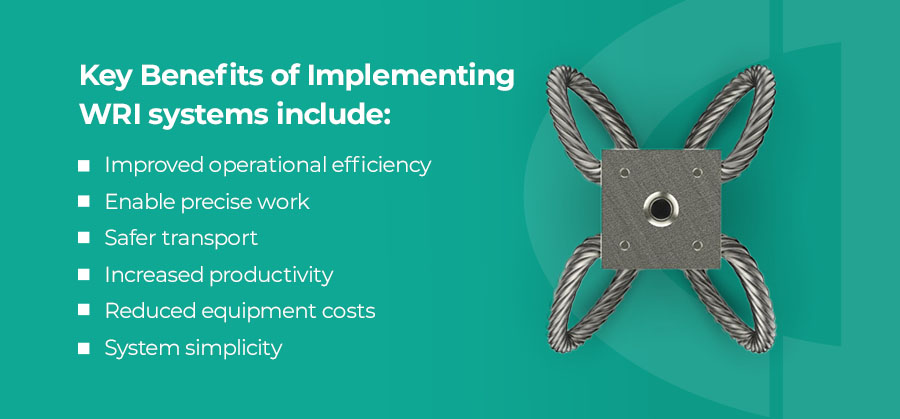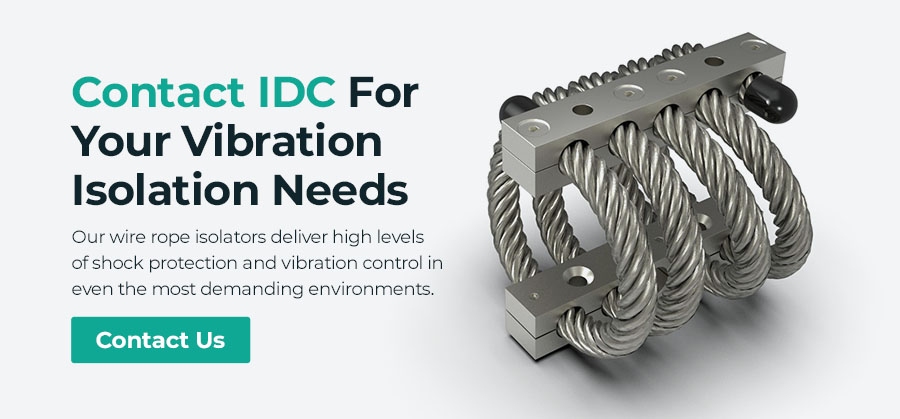What is Vibration Isolation

What is Vibration Isolation?
Unwanted vibrations can cause serious harm to mechanical systems, which is why implementing a means of reducing vibration is so important. Vibration isolation mitigates vibration-caused damage in applications across a wide variety of industries, from aerospace to defense.
This post will provide a comprehensive definition and explanation of vibration isolation, including how it works and why it’s needed.
What is Vibration and What Causes It?
Vibration is a type of mechanical movement where an object oscillates around a point of equilibrium. Visualizations often portray vibration as a wave moving back and forth between a center line, which represents equilibrium — this kind of representation shows the vibration’s amplitude.
There are two different types of vibration:
- Sinusoidal: Oscillation of an object about an equilibrium point. Forced vibration occurs when an object is subjected to an oscillating force, such as those generated by a reciprocating engine or rotating mechanical system. Free vibration occurs when an object is disturbed from its equilibrium and then allowed to oscillate at its own natural frequency without any external force. Without damping, free vibration theoretically will continue forever. Luckily, all materials have some inherent damping!
- Random: Vibration that cannot be predicted but is characterized by statistical probabilities of severity. This is a common method to define vibration that is virtually impossible to quantify, such as vibration subjected to fragile pieces of equipment during transportation.
Two additional vibration phenomena that are important in this discussion include:
- Natural frequency: A system will vibrate at its natural frequency when there is no external force acting on it.
- Resonance: When an external force acts on a system that has the same frequency as its natural frequency, it significantly increases the vibration’s amplitude.
In industrial settings, resonance can become dangerous. The higher a vibration’s amplitude, the more severe the vibration becomes — this can cause physical harm and excessive mechanical damage.
What is Vibration Isolation?
Isolation is the reduction in vibration transmitted to an object. Vibration isolators suppress unwanted vibrations by reducing the system’s natural frequency below its excitation frequency. A damper reduces unwanted vibrations by absorbing vibrational energy.
Most isolators work through the combination of an elastic element, such as a spring, with a damper. However, it is also possible to isolate vibrations without a damper.
Vibration isolation is all-around us: an automobile contains many different types of isolation systems:
- Suspension – The coil springs are the elastic element, while the shock absorbers provide energy absorption to reduce harshness from rough roads.
- Motor mounts – These rubber elements sit between the engine and the chassis of the automobile. They are tuned to a specific frequency for each vehicle to isolate as much vibration as possible across the engine rotational speed range.
- Interior foams – These polymer materials are in seats and typically throughout the car, further reducing structural vibration from the road or engine, as well as noise, which combines to produce a more pleasant in-cabin experience.
Types of Vibration Isolation and How They Work
There are two types of vibration isolation systems — passive and active.
Passive Isolation
Passive vibration isolation is a simple but efficient method of vibration isolation. A passive system consists of three parts:
- An isolated mass, or payload
- A spring or other flexible material
- A damper
The mass combined with the spring’s stiffness defines the system’s natural frequency. The spring softens the incoming vibrations, and then the damper absorbs them.
Common materials used to create passive isolation systems include:
- Rubber: Rubber is viscoelastic, so it provides both elasticity and damping in one medium. This is why it is one of the most common materials for isolation. Natural rubber is very common, but is susceptible to environmental degradation and has relatively low damping. Other synthetic materials are available, such as silicone rubber or polyurethane foams, but these can have drawbacks as well, such as extreme dynamic stiffening or vulnerabilities to moisture.
- Wire rope: Metal wire rope isolators(WRIs) use helical steel cables wrapped around robust retaining bars. In addition to providing superior vibration damping, they’re incredibly durable, heat-tolerant and corrosion-resistant. WRI is very well suited for applications involving random vibration, where it is difficult to predict all possible scenarios.
- Coil Springs: These are one of the oldest types of passive isolation systems. On their own, they are only suitable for isolating steady state sinusoidal vibration where no shock is expected. Spring-based systems often add a damper to compensate, which increases their cost and size.
- Oil: Although it’s rare, some specialized systems use dampers with oil to reduce vibration magnification at resonance frequencies.
The right material for your application largely depends on your industry, the size of your system and your unique needs.
Active Isolation
Active vibration isolation is more complex than passive isolation because it uses a system of sensors and actuators to produce an independent force that cancels out incoming vibrations rather than simply absorbing and dissipating them.
Generally, this type of vibration isolation is stronger at isolating and suppressing unwanted vibrations than passive system, but often is more expensive and requires more maintenance.
An active isolation system typically includes the following components:
- A controller
- A piezoelectric accelerometer
- An electromagnetic transducer
- A feedback circuit
Active isolation systems are common in advanced scientific applications, such as electron microscopy and mass photometry.
Why is Vibration Isolation Important?
Vibration isolation reduces incoming vibrational energy, which protects valuable machinery and equipment from excessive wear. It also may reduce structural noise that can get in the way of operational productivity and decrease your profitability.

Some of the key benefits of implementing WRI systems include:
- Improved operational efficiency: Over time, vibration can cause bolts and screws to loosen, which can lead to decreased equipment performance. Vibration isolators reduce exposure, so machinery can operate at peak performance for longer.
- Enable precise work: Random vibrations can throw off precision measurements, which can derail important scientific work. Vibration isolators help ensure measurements are accurate, protecting lab equipment and researchers.
- Safer transport: Driving off-road or flying through turbulence can expose passengers and cargo to damaging levels of vibrations. Installing isolation systems protects those onboard and helps important transport missions go smoothly.
- Increased productivity: Lost efficiency means reduced throughput and profitability. Vibration isolation systems enable you to maximize output and keep your operations moving for longer.
- Reduced equipment costs: Prolonged exposure to vibration contributes to mechanical wear and tear. Reducing unwanted vibration improves a device’s longevity, which means fewer replacements and less costly maintenance.
- System simplicity: WRI isolators are highly versatile, which enables you to keep your equipment simple and cost-effective. These isolation systems can reduce shock, vibration and structure-borne noise all at once, so you can equip uncomplicated assemblies.
Isolating abnormal vibrations can also protect human operators from bodily harm. Prolonged occupational exposure to vibration can contribute to serious health issues such as:
- Hand-arm vibration syndrome (HAVS)
- Musculoskeletal disorders (MSDs)
- Nerve damage
- Hearing loss
Who Uses Vibration Isolation?
Vibration isolation systems are common in highly regulated, technical industries such as:
- Aerospace
- Automotive
- Industrial & Commercial
- Construction
- Electronics
- Energy
- Manufacturing
- Medical
- Military and defense
- Oil and gas
- Scientific research
You can also find vibration isolation systems in many everyday items, such as household appliances, HVAC systems and consumer electronics.
When is Vibration Isolation Necessary?
Vibration isolation is often needed in motorized mechanical systems, but could be necessary for any object. The two most common reasons for implementing vibration isolation include:
- Protecting a system from the motion of its base, which was excited by an external source.
- Protecting the vibrating system’s foundation from significant transmitted forces caused by rotating unbalanced mass or harmonic excitation.
For the best results, consider requesting a custom vibration isolation solution from an experienced team of engineers. A good company will analyze your current situation and design a system that addresses your specific concerns. You’ll get peace of mind and improved productivity that will pay for itself over time.
IDC's Vibration Isolation Solutions
IDC provides a comprehensive range of vibration isolation solutions suitable for all industries. Additionally, we offer custom-engineered designs to meet your specific wire rope isolator requirements. Some of our most popular wire rope isolation products include:
- M-Series: Our M-Series wire rope isolators are built with robust, fail-safe construction, offering a versatile and cost-effective solution for vibration mitigation.
- SB-Series: Our SB-Series wire rope isolators are designed with a compact structure and shorter bars, making them ideal for use in confined spaces.
- SM-Series: Our SM-Series wire rope isolators feature an S-shaped design that provides exceptional support, balance, and vertical stability.
- XM-Series: Our XM-Series wire rope isolators are designed with a symmetrical X-shape, offering vertical strength and torsional resistance for lighter loads.

Contact IDC For Your Vibration Isolation Needs
Our wire rope isolators deliver high levels of shock protection and vibration control in even the most demanding environments.
In addition to selling turnkey isolators, we develop custom solutions tailored to your unique application, which can include mounting brackets, pallets, rail assemblies, weldments and more. Please get in touch with an IDC engineer for more information.
Speak with a Sales Representative
Our representatives have a wealth of knowledge on all our products – let them steer you in the right direction.
Learn More


